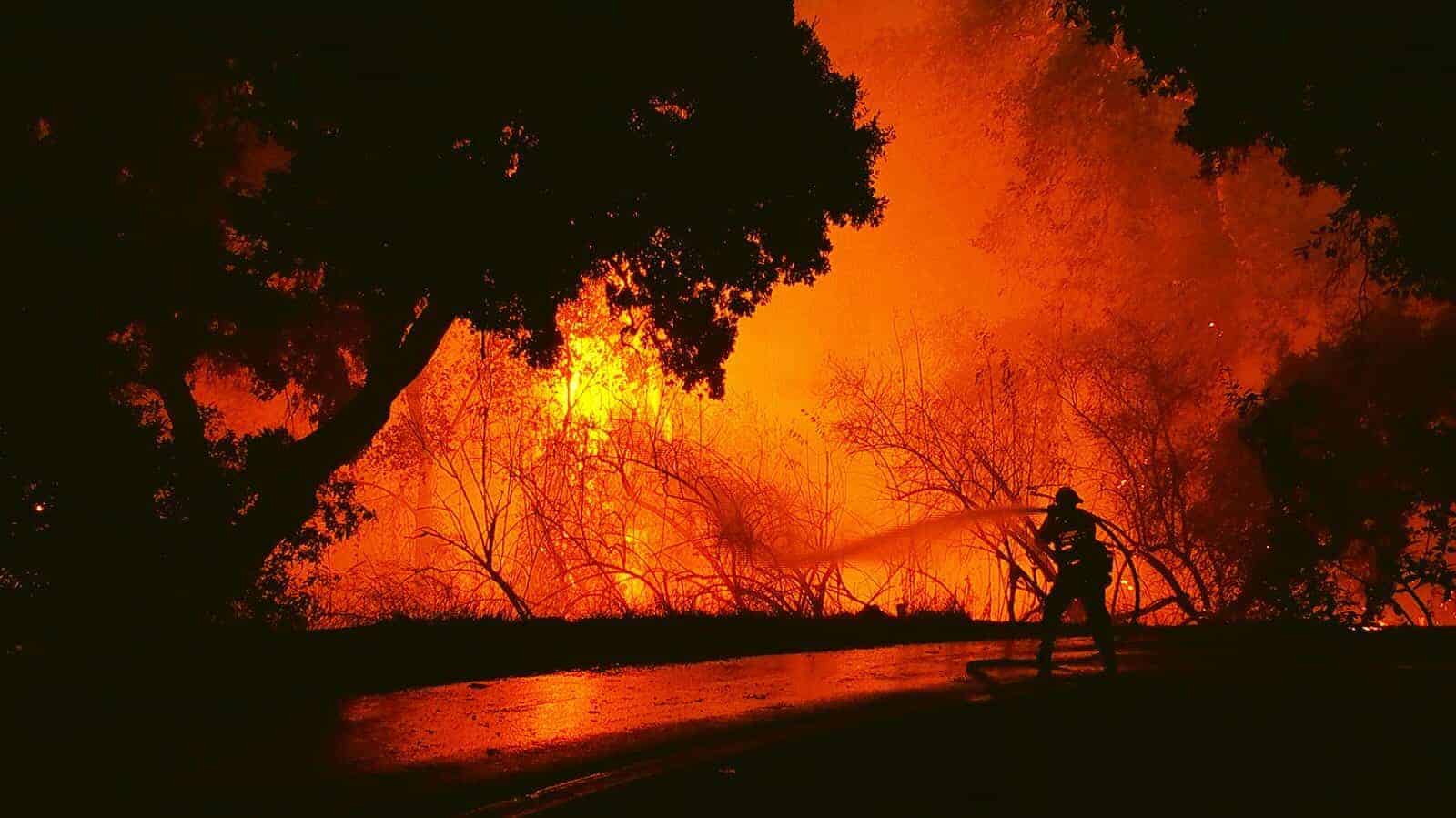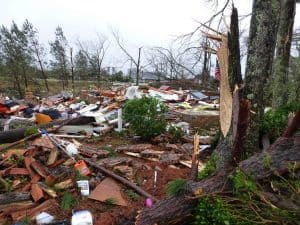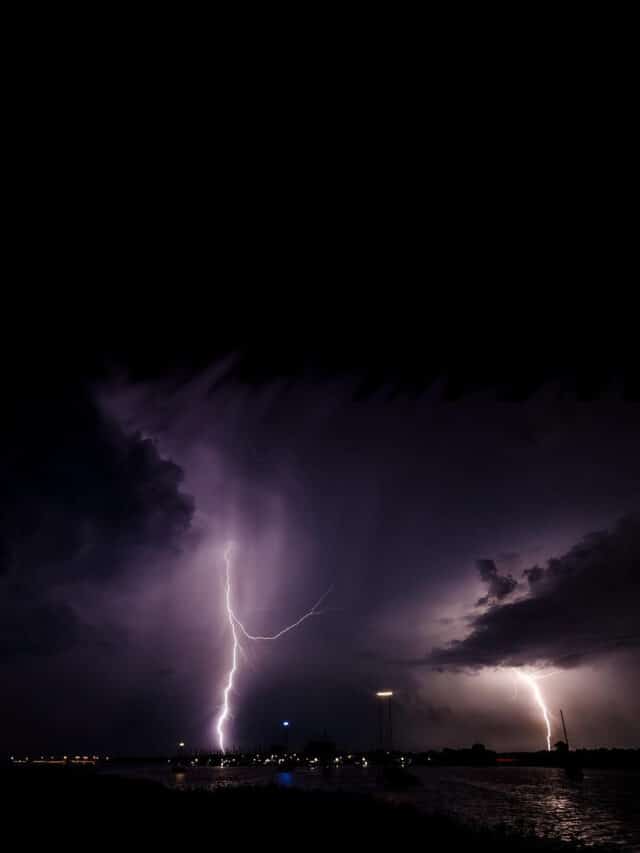Wildfires to Floods – Major Hurricanes and Tornadoes – Drought to Severe Rain and Hail

The Year 2017 Presented the United States with 16 Weather Related Disasters Costing Over 1 Billion Dollars Each. (Image by NOAA)
Perhaps Mother Nature was in a giving mood, but it didn’t seem like she was happy. The New Year started off in January with a southern tornado outbreak and followed up with one disaster after another. Not all the numbers are in. In fact, it may take years to total up the damages and the repairs and the complete losses, not to mention the economic damage to local economies.
The NOAA lists 16 weather disasters from 2017 with an impact of more than 1 billion dollars each. From 1980 -2017 the average number of major disasters was 5.8 per year.
Tornadoes

A Home Completely Destroyed by the Hattiesburg, Mississippi EF3 Tornado. (NWS photo)
2017 saw a record numbers of tornadoes, especially early in the year when four major outbreaks occurred in January, February, March, and April. The hurricanes that made landfall also kicked off large numbers of tornadoes which contributed to the record numbers.
Meteorologists rate tornadoes on the Enhanced Fujita scale, usually abbreviated EF with ratings from 0 to 5. Rather than rate tornadoes on estimated winds, the EF scales rates tornadoes on the amount of damage they cause. An EF0 causes little or no damage at all—it might take the shingles off a rood. A tornado that causes no damage is always rated at 0 even if it was more powerful than a small minor tornado. The scale moves upward from 1 to 5 with Moderate (EF1), Considerable(EF2), Severe(EF3), Extreme(EF4), and Total Destruction(EF5).
Standby Generators Buyer’s Guide: What Size Generator Do I Need
The first major outbreak of the year occurred from January 21 -23 with 81 tornadoes in Mississippi, Louisiana, Arkansas, and Georgia. This outbreak included 3 EF3 tornadoes, 11 EF2 tornadoes and 67 EF0 and EF1. It was the second deadliest January outbreak since 1950. Twenty people lost their lives and the tornadoes injured many more.
A second intense outbreak occurred over February 28 to March 1 with the most devastating damage in Illinois and Missouri. EF3 tornadoes at Ottawa, Crossville, and Washburn killed three people and caused extensive damage. A long tracking EF4 killed one person and destroyed homes near Perryville, Missouri. Eight more EF2 tornadoes caused damage to roofs and uprooted trees. The February-March outbreak produced 72 tornadoes and killed four people across the Ohio Valley and Midwest.

This is all that remains of a two-story brick home after the Eustace-Canton, TX EF4 Tornado. (NWS Photo)
For the second time after less than a week, another Midwest and Ohio Valley outbreak began on March 6 and lasted through March 7 in Iowa, Missouri, and Arkansas with 9 EF2 and 1 EF3 tornadoes along with numerous EF0 and EF1. The Missouri EF3 destroyed about 500 buildings and injured 12 people. The EF2 tornadoes that struck Smithville and Lathrop damaged or destroyed multiple homes. An EF1 at Bricelyn, Minnesota was the earliest Minnesota Tornado ever. Fortunately, no lives were lost in the 63 tornadoes attributed to the March outbreak, though they injured 19 people.
Four Ways to Stay Safe During a Power Outage
A powerful weather system in the Rockies developed from April 28 to May 1 bringing heavy snowfall, torrential rain, and an outbreak of 74 tornadoes including an EF3 and eight EF2s that caused extensive damage in Alabama, Louisiana, Missouri, Texas, and Tennessee. Heavy rain and severe thunderstorms dumped large amounts of rainfall prompting flash flood warnings. Straight line winds unrelated to tornadoes brought hurricane force winds to the Eastern Seaboard. A total of 75 tornadoes caused five deaths and extensive damage while flooding and heavy snowfall took another 15 lives.
All total, there were at least 1,396 tornadoes in the United States in 2017.
Hurricanes
Few people will forget the 2017 Atlantic Hurricane Season. It was the fifth most active season since record keeping started in 1851. All ten of the hurricanes occurred one after the other. The damage estimate currently stands at nearly 300 billion dollars. Three major hurricanes—Harvey, Irma, and Maria—caused most of the damage.
Harvey developed as a low-pressure system southwest of the Cape Verde islands and quickly organized into a tropical storm by August 17. Harvey had a poor start with significant wind shear and at one point forecasters downgraded it to a tropical wave. The remnants of Harvey made it to the Bay of Campeche where it began to strengthen and reorganize, first into a tropical depression on August 23, then undergoing a period of rapid intensification to a Category 4 hurricane by August 25.
Most hurricanes gain forward speed as they make landfall, but Harvey slowed down due to other strong weather influences over Texas. It gradually lost strength as it meandered for three days until it returned to the Gulf of Mexico on August 28. A turn to the North took it into Louisiana and as it slowly lost strength and tropical characteristics by the time it reached Tennessee.
Damage estimates for Harvey currently stand at about 125 Billion dollars. It killed 90 people in the United States and produced up to 60 inches of rain—the most ever for a tropical cyclone in the USA.
While Harvey was churning its way into Texas, Irma was emerging as a tropical wave over the coast of Africa. It organized into a tropical storm with favorable conditions that included low wind shear and warm ocean waters. A hurricane hunter aircraft investigated on September 5 and discovered it had bloomed into a Category 5 hurricane with an exceptionally well-defined eye. Later that day it achieved winds of 185 MPH.
Irma temporarily lost some strength, but regained category-five status before it hit Cuba on September 9. The land mass weakened it again, but as it emerged over the straits of Florida it again regained strength until it made landfall in the Florida Keys, and then again at Marco Island, Florida.
It was the second Category-four Storm to strike the United States within two weeks. It took at least 134 lives—44 across the Caribbean and 90 in the United States. Observers described the islands of Barbuda and Saint Martin as 95 percent destroyed.
On the heels of Irma, another tropical wave crossed the coast of Africa on August 31 and organized into Tropical Storm Jose on September 5. With ocean conditions similar to those associated with Irma’s development, Jose quickly gained strength to become a hurricane on the sixth and ultimately a category-four hurricane with 155 MPH winds.
Have You Made a Hurricane Disaster Plan?
Based on warnings issued ahead of Hurricane Jose, the Antigua-Barbuda government completely evacuated the island of Barbuda because Irma had heavily damaged or destroyed most buildings. Jose made a semi-circle loop off the East Coast before finally dissipating to a post-tropical cyclone on September 22.
On September 6, as Hurricanes Irma and Jose made their way west across the Atlantic, Tropical Depression 13 organized into Tropical Storm Katia. Katia intensified and made landfall near Tecolutia, Mexico on September 8 as a Category 1 Hurricane. Katia deserves mention because it was one of three hurricanes active at the same time.

The South Carolina National Guard Helps with Cleanup Efforts in Caguas, Puerto Rico (SC National Guard Photo)
Hurricane Maria intensified from a tropical storm to a major category-five hurricane in less than 24 hours. It struck Dominica with 160 MPH winds on September 18. After weakening slightly and then intensifying, the center of the storm made landfall two hours later in Puerto Rico with sustained winds that topped 155 MPH.
Maria devastated Dominica and Puerto Rico and destroyed or heavily damaged nearly all the buildings on Dominica. Puerto Rico experienced widespread flooding and the electrical grid was catastrophically damaged. Four months later the island still struggles without power. The official death toll stands at 110 and the damage so far totals more than 90 billion dollars. San Juan Mayor Yulin Cruz states that the actual storm-related deaths may total more than 500.
Prepare Your Home for a Hurricane
Wildfires
Known as the Northern California Firestorm, a series of 250 wildfires began burning across the state of California early in October. They burned at least 245,000 acres of land, including the Tubbs Fire which became the most destructive in California history and caused at least 9.4 Billion dollars.
When the fires began on October 8, they grew rapidly in the extremely dry conditions. The fires forced 80,000 people to evacuate, 185 required hospitalization, and 44 lost their lives. The firestorm caused the largest loss of life due to wildfires in the US since 1918 while destroying approximately 9000 structures including homes and other buildings.
New Wildfires (Some are still burning) began in Southern California in December and have led to 290,000 evacuations. They have burned more than 300,000 acres, destroyed more than 500 homes and buildings, and the still-rising estimated cost totals more than 3 billion dollars.
Other fires in the Western States caused significant damage with combined damages exceeding 1 billion dollars.
How to Use a Portable Generator for Emergency Power
Severe Weather

Northern California Firestorm – A Firefighter Battles a Wildfire in California During the October 2017 Firestorm (NOAA Photo)
Other weather events have taken their toll in 2017. Severe hailstorms, rain, flooding and even freezing weather in the South all had a part to play. 2017 was the costliest year to date in terms of damages, but the economic losses are difficult to accurately total.
Some of these weather events took days to develop, then struck with terrifying ferocity. Who could have known two days earlier how devastating Hurricane Marie would be to the people of Puerto Rico? No one could have guessed that four months later most of those people would still lack basic needs like electricity that we take for granted.
Five years from now, some of the victims of Hurricane Harvey will finally see their homes restored. Others never will.
2017 might be over, but we won’t forget it for a long time.





















